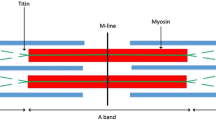Abstract
The purpose of this study was to determine the characteristics of the specific phonomyogram (PMG) of active motor units activated during voluntary isometric contractions. The electromyogram (EMG) and PMG were recorded from 87 anconeus motor units in 14 subjects. The elementary PMG from single motor units was analysed with a spike-triggered averaging technique. The electro-acoustical delay was 3.5 (SD 1.1) ms, which is within the range of values reported in the literature for PMG evoked by motor nerve stimulation. All motor units demonstrated a pattern of impulsive sounds with a duration of 87.2 (SD 10.7) ms. These results would imply that PMG is linked to the contractile activity of the motor units. These results also would suggest that PMG recorded from a contracting muscle in situ reflects the summation of elementary PMG during voluntary contraction more than the overall mechanical properties of the muscle.
Similar content being viewed by others
References
Abbott BC, Ritchie JM (1951) Early tension relaxation during a muscle twitch. J Physiol 113:330–335
Barry DT, (1987) Acoustic signal from skeletal muscle. Biophys J 51:769–773
Barry DT (1991) Muscle sounds from evoked muscle twitches. Arch Phys Med Rehabil 72:573–575
Barry DT (1992) Vibrations and sounds from evoked muscle twitches. Electromyogr Clin Neurophysiol 32:35–40
Barry DT, Cole NM (1988) Fluids mechanics of muscle vibrations. Biophys J 53:899–905
Barry DT, Cole NM (1990) Muscles sounds are emitted at the resonant frequencies of skeletal muscle. IEEE Trans Biomed Eng 37:525–531
Barry DT, Geiringer SR, Ball RD (1985) Acoustic myography: a noninvasive monitor of motor unit fatigue. Muscle Nerve 8:189–194
Basmajian JV (1967) Control of individual motor units. Am J Phys Med 46:480–486
Bolton CF, Parkes T, Thompson RT, Clark MR, Sterne J (1989) Recording sounds from human skeletal muscle: technical and physiological aspects. Muscle Nerve 12:126–134
Calancie B, Bawa P (1986) Limitations of the spike-triggered-averaging technique. J Neurophysiol 9:78–83
Coles RRA, Garinther GR, Hodge DC, Rice CG (1968) Hazardous exposure to impulse noise. J Acoust Soc Am 43:336–343
Foix C, Thévenard A, Dupasquier C (1923) Enregistrement du bruit musculaire par le galvanomètre á corde et l'amplificateur de basse fréquence (phonomyogrammes). Données relative á la contracture et á la contraction. Contraction cinétique et contraction statique (posturale). C R Soc Biol 89:733–735
Frangioni JV, Kwann-Gett TS, Dobrunz LE, McMahon TA (1987) The mechanism of low-frequency sound production in muscle. Biophys J 51:775–783
Gordon G, Holbourn AHS (1948) The sounds from single motor units in a contracting muscle. J Physiol 107:456–464
Hamernik RP, Hsueh KD (1991) Impulse noise: some definitions, physical acoustics and other considerations. J Acoust Soc Am 90:189–196
Hennemann E, Olson CB (1965) Relations between structure and function in the design of skeletal muscles. J Neurophysiol 28:581–598
Hill AV (1949) The abrupt transition from rest to activity in muscle. Proc R Soc Lond [Biol] 136:399–420
Houles A (1979) Contribution a l'étude de l'environnement acoustique de l'homme. Etude métrologique des bruits impulsifs répétitifs. Thesis', University of Toulouse, Toulouse
Hufschmidt H (1985) Acoustic phenomena in the latent period of skeletal muscle: a simple method for in vivo measurement of the electromechanic latency. Pflügers Arch 404:162–165
Jorgensen F, Lammert O (1976) Acceleromyography (AMG) II:contribution of the motor unit. In: Komi PV (ed) Biomechanics V-A. University Park Press, Baltimore, pp 159-164
Le Bozec S, Maton B (1982) The activity of Anconeus during voluntary elbow extension: the effect of lidocaine blocking of the muscle. Electromyogr Clin Neurophysiol 22:265–275
Le Bozec S, Maton B (1987) Differences between motor unit firing rate, twitch characteristics and fiber composition within an agonistic muscle group in man. Eur J Appl Physiol 56:350–355
Maton B, Petitjean M, Cnockaert JC (1990) Phonomyogram and electromyogram relationships with isometric force reinvestigated in man. Eur J Appl Physiol 60:194–201
Milner-Brown HS, Stein RB, Yemm R (1973) The contractile properties of human motor units during voluntary isometric contractions. J Physiol 228:285–306
Nörstrom MA, Miles TS, Veale JL (1989) Effect of motor unit firing pattern on twitches obtained by spike-triggered averaging. Muscle Nerve 12:556–567
Orizio C (1992) Soundmyogram and EMG cross-spectrum during exhausting isometric contractions in humans. J Electromyogr Kinesiol 2:141–149
Orizio C (1993) Muscle sounds: bases for the introduction of a mechanomyographic signal in muscle studies. Crit Rev Biomed Eng 21:201–243
Orizio C, Perini R, Veicsteinas A (1989) Muscular sound and force relationship during isometric contraction in man. Eur J Appl Physiol 58:528–533
Orizio C, Solomonow M, Baratta R, Veicsteinas A (1993) Influence of motor units recruitment and firing rate on the soundmyogram and EMG characteristics in cat gastrocnemius. J Electromyogr Kinesiol 2:232–241
Oster G (1984) Muscle sounds. Sci Am 250:108–114
Oster G, Jaffe JS (1980) Low frequency sounds from sustained contraction of human skeletal muscle. Biophys J 30:119–127
Petitjean M, Maton B, Cnockaert JC (1992) Evaluation of human dynamic contraction by phonomyography. J Appl Physiol 73:2567–2573
Rouanet H, Lépine D (1970) Comparison between treatments in a repeated-measurement design: ANOVA and multivariate methods. Br J Math Stat Psychol 23:147–163
Sandow A (1944) Studies on the latent period of muscular contraction. General properties of latency relaxation. J Cell Comp Physiol 24:221–256
Stokes IAF, Moffroid PT, Rush S, Haugh LD (1988) Comparison of acoustic and electrical signals from erectores spinae muscles. Muscle Nerve 11:331–336
Stokes MJ, Dalton PA (1991) Acoustic myography activity increases linearly up to maximal voluntary isometric force in the human quadriceps muscle. J Neurol Sci 101:163–167
Stokes MJ, Cooper RJ (1992) Muscles sounds during voluntary and stimulated contractions of the human adductor pollicis muscle. J Appl Physiol 72:1908–1913
Author information
Authors and Affiliations
Rights and permissions
About this article
Cite this article
Petitjean, M., Maton, B. Phonomyogram from single motor units during voluntary isometric contraction. Europ. J. Appl. Physiol. 71, 215–222 (1995). https://doi.org/10.1007/BF00854981
Accepted:
Issue Date:
DOI: https://doi.org/10.1007/BF00854981




